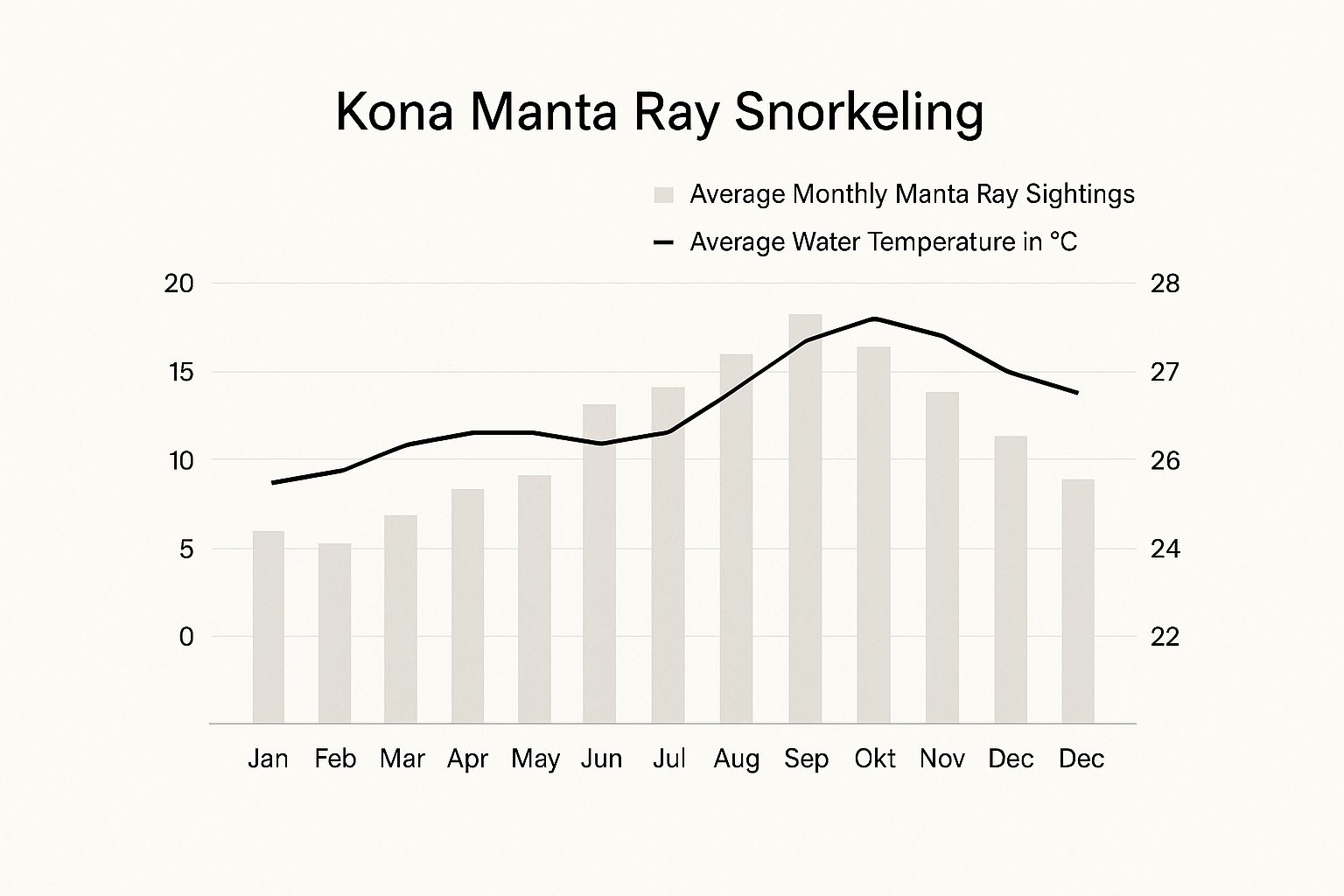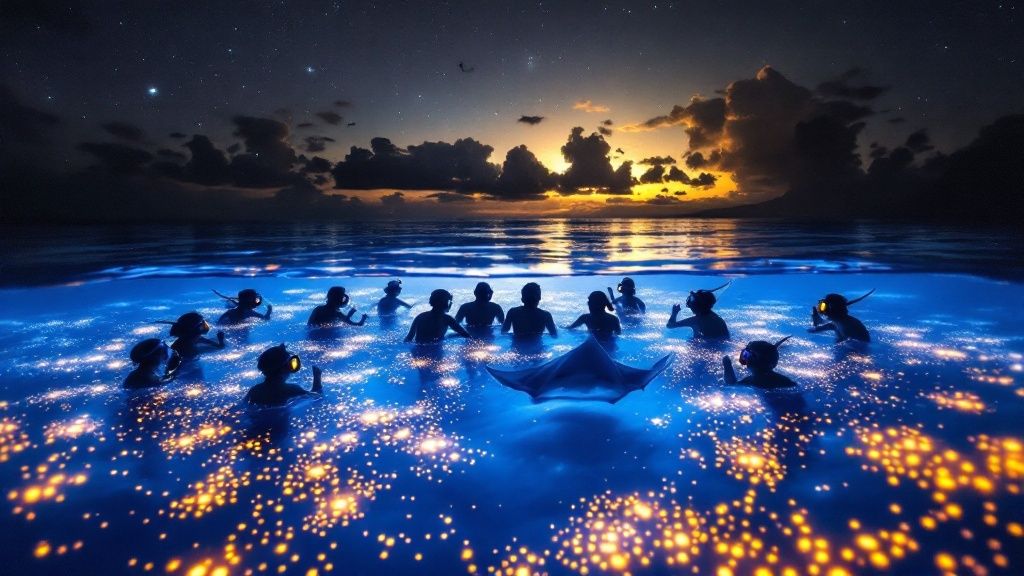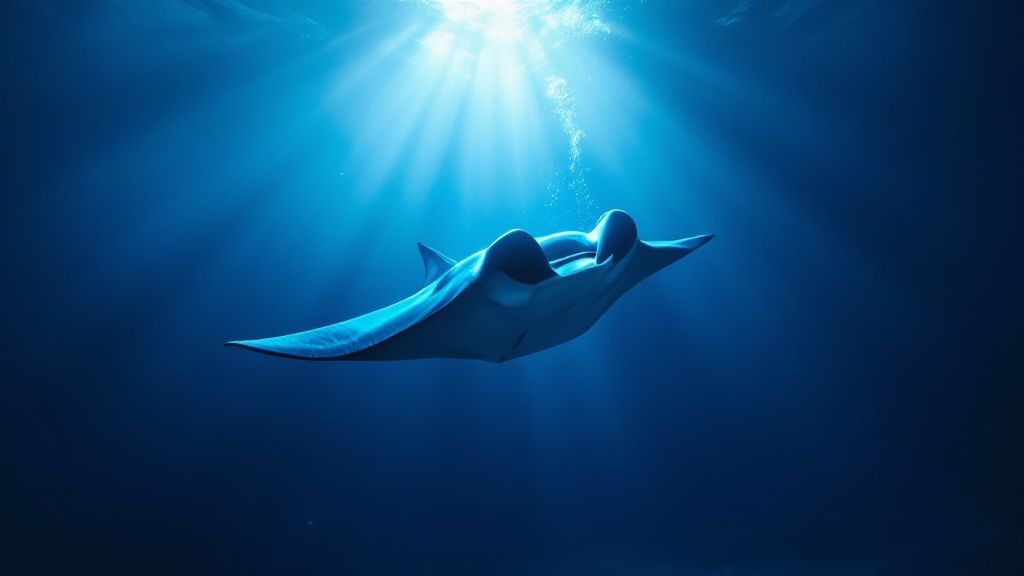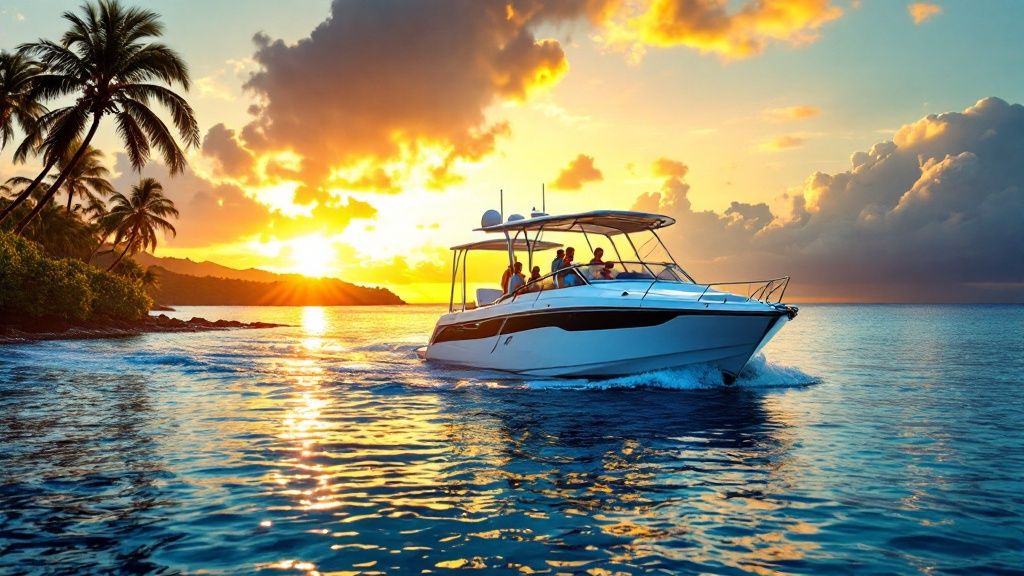The Magic of Manta Ray Snorkel Kona Hawaii

Picture yourself floating in the warm Pacific waters beneath a canopy of stars. Out of the darkness, a huge, gentle creature with a wingspan reaching up to 16 feet emerges, gliding silently and gracefully just inches away. This isn't make-believe; it's the very real manta ray snorkel kona hawaii experience, frequently celebrated as one of the world's most extraordinary wildlife encounters.
Why is Kona such a dependable place to see these magnificent animals? It comes down to specific environmental conditions along the coast that create an ideal habitat for plankton, the mantas' main food. This natural abundance, combined with careful tourism management, results in encounters that are both stunning and highly likely.
Kona's Unmatched Sighting Reliability
The chance of seeing manta rays in Kona is remarkably high. Kona's manta ray tours have some of the best wildlife interaction success rates anywhere, often hitting 80-90%. This is considerably higher than other well-known spots like Australia's Ningaloo Reef (60-70%) or Indonesia's Raja Ampat (50-60%).
This consistency stems from well-managed practices, including specific viewing locations and the use of underwater lights. These lights attract plankton, which naturally draws in the filter-feeding mantas. This thoughtful approach has cemented Kona's reputation for premier wildlife viewing. Explore this topic further.
To better understand how Kona compares globally, the table below details manta ray sighting success rates in several popular destinations.
Manta Ray Encounter Success Rates by Location
Comparison of manta ray sighting success rates across popular global destinations
| Location | Success Rate | Best Season | Average Encounter Duration |
|---|---|---|---|
| Kona, Hawaii | 80-90% | Year-round | ~30-45 minutes |
| Ningaloo Reef, Australia | 60-70% | Mar – Aug | ~20-30 minutes |
| Raja Ampat, Indonesia | 50-60% | Oct – Apr | ~20-30 minutes |
| Hanifaru Bay, Maldives | Variable (High Seasonally) | May – Nov | ~20-40 minutes (seasonal) |
As the table shows, Kona offers a significantly higher probability of encountering manta rays compared to other major locations, making it a top choice for reliability.
An Otherworldly Nighttime Ballet
The experience becomes truly special after dark. Unlike many wildlife excursions, the Kona manta snorkel primarily takes place at night. Tour boats head to designated areas where powerful, yet harmless, underwater lights are set up. These lights attract dense clouds of plankton, essentially creating a concentrated feeding station that lures the mantas.
Floating on the surface above this illuminated area, you witness an incredible underwater performance. The mantas execute mesmerizing barrel rolls and graceful loops, effortlessly scooping up plankton just beneath the surface. The stark contrast between the deep dark ocean and the brightly lit feeding zone creates an almost dreamlike atmosphere, enhancing the feeling of wonder.
It's an intimate, peaceful, and deeply affecting experience. Visitors often leave with unforgettable memories and a newfound respect for these gentle giants of the sea. You might find more details about the Kona Honu Divers manta ray snorkel helpful.
Dancing with Gentle Giants: Understanding Kona's Mantas

Getting to know Kona's manta rays before you meet them makes the encounter even more special. These aren't just giant fish passing by; they're smart, distinct creatures that consider these waters their home. This understanding turns a manta ray snorkel kona hawaii trip into a truly personal connection.
Meet the Kona Mantas: Biology and Behavior
The mantas you'll see along the Kona coast are mostly Reef Manta Rays (Mobula alfredi). They look impressive, with wingspans reaching 14 feet or even wider, but they're completely harmless. As filter feeders, they don't have the stingers their ray cousins possess, posing zero threat to people.
Here's what makes them unique:
- Diet: They primarily eat tiny plankton, filtering huge amounts of water through special plates in their gills.
- Intelligence: Mantas have the largest brain-to-body weight ratio among fish. They show complex social interactions and seem genuinely curious.
- Identification: Every manta ray has a unique spot pattern on its belly, like a natural fingerprint. Researchers and guides use these patterns to tell individuals apart, sometimes even giving them names like the well-known "Big Bertha."
Why Kona Is a Manta Hotspot
So, why Kona? It's all about the food! Kona's coastline naturally has plankton, and at night, tour operators use bright lights. These lights attract swarms of plankton, creating a concentrated feast that reliably draws the mantas to specific spots for dinner.
You'll get to see their amazing feeding techniques, like barrel rolls and graceful loops, as they efficiently scoop up microscopic meals. This consistent food source means the mantas stick around, showing strong site fidelity. Records show that over 120 distinct rays might be identified each year at Kona's main locations.
Interestingly, the top 20 most frequently seen mantas can make up nearly 60% of all sightings! This shows just how attached some individuals are to these feeding areas. On a typical night snorkel, you could see anywhere from 5-15 rays, including some giants with 12-16 foot wingspans. This predictable gathering also helps conservation, as tour operators contribute to research through permit fees. Find more detailed statistics here.
Learning about their biology and why they gather here makes your snorkel more than just watching; it becomes a meaningful interaction. Discover more in our article about What Is the Best Time of Year to See Manta Rays in Kona?. Realizing you might be swimming alongside specific, recognized individuals adds a whole new level of wonder to the experience.
Prime Locations: Where Magic Happens in Kona's Waters

While seeing manta rays in Kona is incredibly reliable, where you go definitely shapes your experience. The manta ray snorkel kona hawaii adventure mainly happens at two famous spots along the coast. Each offers its own unique brand of underwater magic, born from history, ocean currents, and thoughtful tourism practices.
Kona's status as a top manta destination isn't just luck. The local manta snorkeling scene now draws about 80,000 visitors each year. They come for the amazing sighting success rates, which stay consistently between 80-90% all year long! This consistency is thanks to nutrient-rich waters that attract the plankton manta rays love to eat.
This whole activity really kicked off in the early 1990s. Divers noticed mantas feeding near artificial lights, which sparked the idea for the organized tours we enjoy today. Top operators like Kona Honu Divers often see several mantas, including well-known individuals like "Lefty" (identified by unique spot patterns!), doing their famous barrel rolls at sites like Manta Village and Manta Heaven. You can Explore this topic further to learn more about these fascinating creatures.
Manta Village (Keauhou Bay)
Often called the original manta hotspot, Manta Village sits just south of Kailua-Kona, near the entrance to Keauhou Bay. Legend has it that lights from a nearby hotel first attracted plankton (and then mantas) decades ago.
Here’s what makes Manta Village stand out:
- Accessibility: It's usually just a short boat ride from Keauhou Harbor.
- Conditions: The water here is often calmer and relatively shallow for manta sites, typically around 25-35 feet deep.
- Experience: Known for very reliable sightings, making it a go-to choice for many tours, including those from companies like Kona Snorkel Trips.
Its history and dependability make Manta Village a favorite, especially if you prefer potentially calmer seas or a shorter trip out on the water.
Manta Heaven (Garden Eel Cove)
Head a bit further north, near Ellison Onizuka Kona International Airport at Keāhole, and you'll find Manta Heaven, also known as Garden Eel Cove. This spot gained popularity after Manta Village and offers a slightly different vibe.
Key points about Manta Heaven include:
- Accessibility: You'll need a boat trip, typically leaving from Honokohau Harbor, north of Kailua-Kona. Operators such as Kona Honu Divers often bring groups here.
- Conditions: Sometimes the water can be a bit deeper or have more current compared to Manta Village, although conditions change nightly.
- Experience: Some tour providers, like Manta Ray Night Snorkel Hawaii, mention that this location sometimes attracts larger groups of mantas, offering potentially spectacular views.
Manta Heaven provides another fantastic opportunity. It's sometimes favored by divers or those hoping for a chance to see bigger gatherings of mantas, though the number of sightings can vary.
Comparing Kona's Premier Manta Ray Snorkel Sites
To help you decide which spot is right for your adventure, here’s a quick comparison:
Comparing Kona's Premier Manta Ray Snorkel Sites
Detailed comparison of Manta Village vs Manta Heaven sites for snorkelers
| Features | Manta Village (Keauhou Bay) | Manta Heaven (Garden Eel Cove) | Best For |
|---|---|---|---|
| Location | South of Kailua-Kona | North of Kailua-Kona (near Airport) | Proximity to your accommodation |
| Departure Port | Keauhou Harbor | Honokohau Harbor | Convenience based on departure point |
| Typical Depth | ~25-35 feet | ~30-45 feet | Snorkelers preferring shallower water (Manta Village) |
| Water Conditions | Often calmer, more protected bay | Can be slightly more exposed to swell/current | Those prioritizing potentially calmer seas (Manta Village) |
| Accessibility | Generally shorter boat ride | Slightly longer boat ride | Those potentially sensitive to motion sickness (Manta Village) |
| Reputation | Highly consistent sightings, original site | Can host large numbers, also popular dive site | Consistent views (Manta Village) vs. potentially larger groups (Manta Heaven) |
| Operators | Various, including Captain Cook Snorkeling Tours | Various, including Kona Honu Divers | Operator preference, specific tour features |
Both locations offer incredible chances to see mantas, but knowing these differences can help you pick the perfect manta ray snorkel kona hawaii tour for your comfort and expectations.
No matter which location you choose, the trick to getting the best view is sticking close to the tour's light source. This light attracts the plankton, which in turn draws the mantas right to you, usually while you hold onto a custom float provided by the tour company.
Selecting Your Perfect Manta Ray Tour Experience
Picking the perfect spot like Manta Village or Manta Heaven is a great start for your manta ray snorkel Kona Hawaii trip. But with so many boats out there each night, the tour operator you choose really shapes your experience. Who you go with can make a huge difference in having a safe, comfortable, and unforgettable time with the mantas.
Key Factors To Consider
When comparing operators, look past the price. Think about the quality of the boat they use and, importantly, the group size. Smaller groups usually mean a more personal trip and less jostling for position near the lights, giving you clearer views of the mantas.
Also, pay attention to the experience level of the guides and the company's safety measures. Good guides keep you safe and share fascinating insights about the mantas and their world. Seek out tours that offer detailed safety talks and use gear that's clearly looked after. Going with a company known for its skilled team, like a top-rated dive shop, can really upgrade your adventure. Find out more in our article: What Makes Kona Honu Divers the Best Dive Shop in Kona.
Questions To Ask Before Booking
Before you book any tour, it's smart to ask a few questions to see if they're the right fit for you:
- What's the maximum group size allowed per boat or guide?
- What safety gear do you provide (like wetsuits or flotation devices)?
- How much time do snorkelers actually get in the water with the mantas? (This is typically 20-45 minutes.)
- Do you offer a "manta guarantee" in case no rays show up? (Many good operators have this policy!)
- Are your tours eco-conscious, following established guidelines for interacting responsibly with mantas?
Getting answers to these helps you properly compare your choices and select a tour that matches what you want from your manta ray snorkel Kona Hawaii experience.
Finding Your Niche: Specialized Tours
Tour operators often have their own style, fitting different kinds of snorkelers. Some focus on particular types of trips:
- Intimate Encounters: Operators like Kona Honu Divers often run tours with smaller groups, offering a more personal feel and potentially better viewing.
- Photography Focus: If getting great photos is your main aim, check out companies like Manta Ray Night Snorkel Hawaii that might cater more to underwater photographers.
- Family Options: Businesses such as Captain Cook Snorkeling Tours may have trips better suited for families, possibly offering extra help for those less confident in the water.
- Shorter Trips: If you're short on time or just want to get straight to the mantas, providers like Kona Snorkel Trips sometimes have quicker tours focused mainly on the manta viewing.
Lastly, make sure to book your tour ahead of time. This is especially true during popular periods like the winter months or school holidays. Booking early in your vacation also gives you some wiggle room if weather forces a change or if you need to use a "manta guarantee". Planning ahead helps lock in your spot for this amazing Kona adventure.
Your Night with the Mantas: What to Really Expect

The excitement starts building as you head out for your manta ray snorkel kona hawaii adventure. Checking in is usually pretty simple, often at a spot near the harbor or maybe even a resort, like the locations used by Kona Snorkel Trips. You'll sign waivers and get fitted with your gear – mask, snorkel, and fins.
Pre-Dive Preparations
Before you get on the boat, the guides will give a really important safety briefing. They'll show you how to use the equipment, explain what happens in the water, and cover the crucial rules for interacting with the mantas. The biggest rule is no touching the rays. This briefing helps everyone feel comfortable and know how to keep themselves and the mantas safe.
The boat trip to the viewing spot is usually quick, often just 5-15 minutes, especially if you're going to a site like Manta Village near Keauhou. Once the boat anchors, the crew sets up a special lighting system. This is often a large floating raft or board with bright underwater lights aimed down. These lights are the secret sauce, attracting the plankton that the mantas come to feed on.
Entering the Mantas' World
Slipping into the dark ocean at night might feel a bit intimidating, but the guides are great at helping people feel at ease. You'll likely get a pool noodle for extra flotation. Just follow their lead as you get into the water and swim a short way to the light board. Find a handle around the edge and hold on.
Guides from experienced companies like Kona Honu Divers or Manta Ray Night Snorkel Hawaii are typically right there in the water with you. They provide support and point out the mantas as they arrive. And remember, if you're not quite comfortable getting in, you can usually still watch from the boat.
Comfort and Practicalities
It's an amazing experience, but thinking about a few practical things can make it even better:
- Water Temperature: Even in Hawaii, the ocean can feel chilly at night. You'll likely be in the water for 20-45 minutes. Wetsuits are definitely a good idea; most tours offer them, sometimes for a small rental fee.
- Seasickness: If motion sickness is a concern for you, take your preferred remedy before the tour starts. The boat ride is short, but it's always better to be prepared.
- What to Bring:
- Your swimsuit (best to wear it there)
- A towel and warm, dry clothes for afterwards
- Seasickness remedy, just in case
- A reusable water bottle
- An underwater camera (optional, but fun!)
Try to mentally prepare by focusing on the incredible wildlife encounter ahead. Trust your guides, take some deep breaths, and just float. Before you know it, you'll be mesmerized by these gentle giants gliding silently beneath you. If you're thinking about diving deeper, check out options for Hawaii Night Dives with Manta Rays. Dependable operators like Captain Cook Snorkeling Tours also focus on making sure everyone feels safe and comfortable.
Capturing the Magic: Photography Tips for Manta Encounters
After witnessing the incredible manta ray snorkel kona hawaii experience, you'll definitely want some photos or videos to remember it by. Shooting underwater at night comes with its own set of difficulties, but with a few smart tips, you can capture images that really show off the amazing sights.
Choosing Your Camera Gear
Good news – you don't need a Hollywood budget to get great shots! Many people get fantastic results with common gear that works well for this kind of adventure:
- Action Cameras: Cameras like GoPro are a go-to choice. They're small, already waterproof, and newer models handle low light surprisingly well. Just make sure you have a secure wrist strap or float so you don't lose it!
- Smartphones: Believe it or not, your phone can do a great job with a dependable underwater housing. Stick close to the tour's light source for the best results.
- Dedicated Underwater Cameras: If you're aiming for higher quality, compact underwater cameras or even fancier setups with external lights give you more control. Sometimes on tours like Manta Ray Night Snorkel Hawaii, you might even meet other photo fans with serious gear.
Camera Settings and Techniques for Low Light
Taking pictures in the dark ocean means changing how you shoot. The bright lights used by tours, such as those from Kona Honu Divers, are key. They light up the mantas against the black water, creating a perfect stage.
Try these suggestions for better photos and video:
- Prioritize Video: It's often easier to capture the smooth, flowing movements of the mantas on video, especially in low light with lots of motion. Video lets you relive their amazing underwater dance.
- Get Close (Respectfully): Light doesn't travel far underwater. The nearer you are to the main lights and the mantas (while keeping a safe distance, of course), the more color and detail your camera will pick up.
- Stability is Key: Keep your camera as steady as you can. Use the light board or float provided by the tour to help reduce shaky shots. It's better to let the mantas swim into your frame rather than chasing them around.
- Basic Settings: If you can adjust settings, try a wider aperture (that's a lower f-number) to let more light in. Keep the ISO setting as low as you can while still getting a bright picture to avoid grainy images. For photos, a slightly faster shutter speed might help freeze the action, but video is usually more forgiving.
Positioning and Respectful Photography
You'll often get the best shots by being patient and respectful, not by chasing. Trying to follow a manta rarely works well for photos and can bother them, maybe even scaring them away from the lights.
Find a spot near the light board provided by operators like Kona Snorkel Trips and let the mantas come to you. This usually leads to better images and videos. When mantas feel safe, they're more likely to do their cool feeding loops and maybe even some close-up barrel rolls near the lights.
Remember the crucial rule: never reach out or attempt to touch the mantas. Touching them can damage the protective slime coat on their skin, which they need to stay healthy.
Quick Post-Processing Pointers
A few quick edits after your trip can really make your underwater photos look better. Using simple photo or video editing software, you can usually fix:
- Color Balance: Underwater shots often look very blue or green. Adjusting the white balance helps bring back more natural colors.
- Contrast and Clarity: Adding a little contrast can make the mantas pop against the dark background. Sharpening can bring out details, but don't overdo it, or it might look unnatural.
The idea isn't to change the picture completely, but just to adjust for the tricky underwater lighting. This helps your photos better show the true beauty of your manta ray snorkel kona hawaii adventure with experienced guides like those at Captain Cook Snorkeling Tours.
Swimming with Purpose: Conservation & Responsible Tourism
Your manta ray snorkel kona hawaii trip is more than just an amazing underwater show; it's a chance to connect directly with marine conservation. The nightly gathering you'll see is known worldwide as a prime example of how wildlife tourism, when done right, can actually help protect these incredible animals. This careful approach is essential for the future of Kona's gentle giants.
Guidelines for Guardianship
Protecting Kona's manta rays means following clear rules. Mantas reproduce slowly and face dangers like getting tangled in fishing gear, so limiting our impact during swims is really important. Good tour companies follow strict, science-backed guidelines to keep the rays and their home safe.
These rules usually involve:
- Passive Observation: Snorkelers stay mostly in one spot, often holding onto a light float. This lets the mantas come close if they choose, without feeling chased or cornered. Never swim after them or block their path.
- No Touching Rule: Mantas have a special slime coat that protects them from infection. Touching them can damage this layer. Maintaining a respectful distance is vital for their health.
- Controlled Lighting: Lights draw in the plankton mantas eat, but operators use them carefully. They manage the lights to avoid disrupting manta behavior away from the main viewing spot.
Choosing tour operators who clearly follow and enforce these standards helps make sure your adventure has a positive effect.
How Your Tour Makes a Difference
Going on a well-managed manta ray snorkel helps conservation in real ways, beyond just creating memories. Often, a part of your tour cost goes directly to support research projects, programs that identify individual manta rays, and efforts to protect their habitat along the Kona coast.
This creates a positive feedback loop: the presence of the mantas helps bring in the money needed to study and protect them. Companies focused on sustainability frequently work with groups like the Manta Pacific Research Foundation, sharing sighting information and raising awareness. This teamwork helps ensure the local manta population stays healthy for the long run.
Becoming a Citizen Scientist
You can even help with research during your snorkel trip through citizen science. Many visitors contribute important information without even knowing it. Here’s how:
- Photo Identification: Those unique spot patterns on each manta's belly are like fingerprints. If you take underwater photos or videos, you can send them to researchers. These images help track specific mantas, check population numbers, learn about their movements, and check their health.
- Behavior Observation: Just watching how the mantas act – how they feed, interact with each other, or if they have any unusual marks – provides useful details when shared with your guides or research teams.
Getting involved like this makes your connection to the animals and their environment even stronger. You become more than just a visitor; you actively help build the knowledge needed to protect them. Find out more in our article about Why You Should Go on a Manta Ray Dive in Kona. Knowing this background makes your manta ray snorkel kona hawaii experience truly meaningful.
Understanding that your visit actively helps preserve these magnificent creatures adds an extra layer of awe to the experience. You'll leave Kona not just with amazing memories, but also knowing you responsibly took part in a world-class conservation success story, helping to ensure others can see this magic in the future.
Ready to experience the wonder of Kona's manta rays responsibly? Book your unforgettable manta ray snorkel or dive adventure with Kona Honu Divers today!
